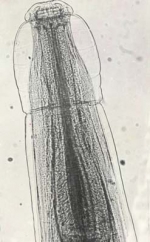NEIHPID
North-East India Helminth Parasite Information Database
Recently added
Parasites
Molecular Data
Oesophagostomum (Hysteracrum) aspersum (Railiet et Henry Railiet et Henry)
Taxonomy
Nematoda »
SECERNENTEA »
Chabertiidae (Popova, 1952) Lichtenfels, 1980 »
Oesophagostominae Railliet, 1916 »
Oesophagostomum Molin, 1861 »
Oesophagostomum (Hysteracrum) aspersum, Railiet et Henry 1913
Synonyms
(Oesophagostomum aspersum Railliet et Henry, 1913)
Host
Capra (hircus), Ovis (aries)
Habitat
Caecum, Large intestine
Locality
Shillong (Meghalaya), Nongstoin (Meghalaya), Jowai (Meghalaya), Markasa (Meghalaya)
Description
General
Mouth-collar in form of truncated cone, marked off by a well-defined groove posteriorly. Cephalic inflation of cuticle very well developed. Pair of cervical papillae situated little behind oesophago-intestinal valve. Cervical groove well marked ventrally , extending little behind lateral line. External corona radiata consisting of twelve bluntly rounded elements, internal crown having twenty four small elements. Buccal capsule shallow, its base at level of posterior limit of mouth-collar. Oesophagus club shaped, possessing oesophago-intestinal valve. Nerve ring lying just behind cervical groove.
Male
Body 11.0-14.0 mm long, 0.39-0.46 in maximum width. Bursa well developed, with following arrangement of rays in it : ventral ray cleft, medio-lateral and postero-laterals fused proximally, externo-dorsals arising from common trunk with dorsal, latter divided into two divergent branches, each of which gives off a short lateral branch. Pair of pre-bursal papillae present in front of bursa. Spicules paired, equal. Accessory piece present, handle of shovel missing or sometimes represented by small, rounded knob.
Female
Body 15.0-17.0 mm in length, 0.46-0.50 mm in maximum width. Tail tapering abruptly, bearing pair of very small papillae just near its tip. Anus rather prominent. Vulva situated at little distance from posterior end of body. Vagina long, opening into relatively anteriorly placed ovejectors. Eggs oval, thin shelled, 0.06-0.08 x 0.03-0.04 mm.
Remarks
Railliet and Henry (1913) erected a sub-genus Hysteracrum for the reception of this species based on the length of spicules and vagina and the position of cervical papillae in relation to the oesophageal expansion. This parasite has earlier been described from several states in India (Thapar ,1956; Alwar and Lalitha, 1961; Bhatia and Pande, 1961;Patnail, 1964). The species, namely O. indicum Maplestone, 1930 from sheep and deer, and O. bhandari Rao et Bhatavadekar, (1958) from goat are considered synonym of O. aspersum.
Except for minor morphometric and structural variations, such as the absence of cervical papillae and gubernaculum in few specimens, the observations tally closely with those provided by Baylis (1936a). Meghalaya forms a new locality record for this species.
Helminthological collections record
NEHU/Z - NM/20
References
Railliet, A. and Henry, A. (1913). Sur les oesophagostomiens des ruminants. Bulletin de la Societe de Pathologie Exotique. 6:pp 506-511.
Thapar, G. S. (1956). Systematic survey of helminth parasites of domesticated animals in India. Indian Journal of Veterinary Sciences. 27:pp 67-77.
Alwar, V. S. and Lalitha, C. M. (1961) A check-list of the helminth parasites in the Department of Parasitology, Madras Veterinary College (additions since 1954). Indian Veterinary Journal. 38:pp 142-148.
Bhatia, B. B. and Pande, B. P. (1961) On the common helminthic infections of large intestine in Indian sheep with remarks on two of the pathogenic species. Indian Journal of Helminthology. 13:pp 1-22.
Patnail, M. M. (1964). On the synonymy of Oesophgostomum bhandarai with Oesophagostomum aspersum. Indian Veterinary Journal. 41:pp 271-272.
Baylis, H.A. (1936a) The Fauna of British India including Ceylon and Burma. Nematoda Vol. I (Ascaroidea and Strongyloidea). Originally published by Taylor and Francis, London (reprinted edition : Today



aspersum (outline).jpg)
